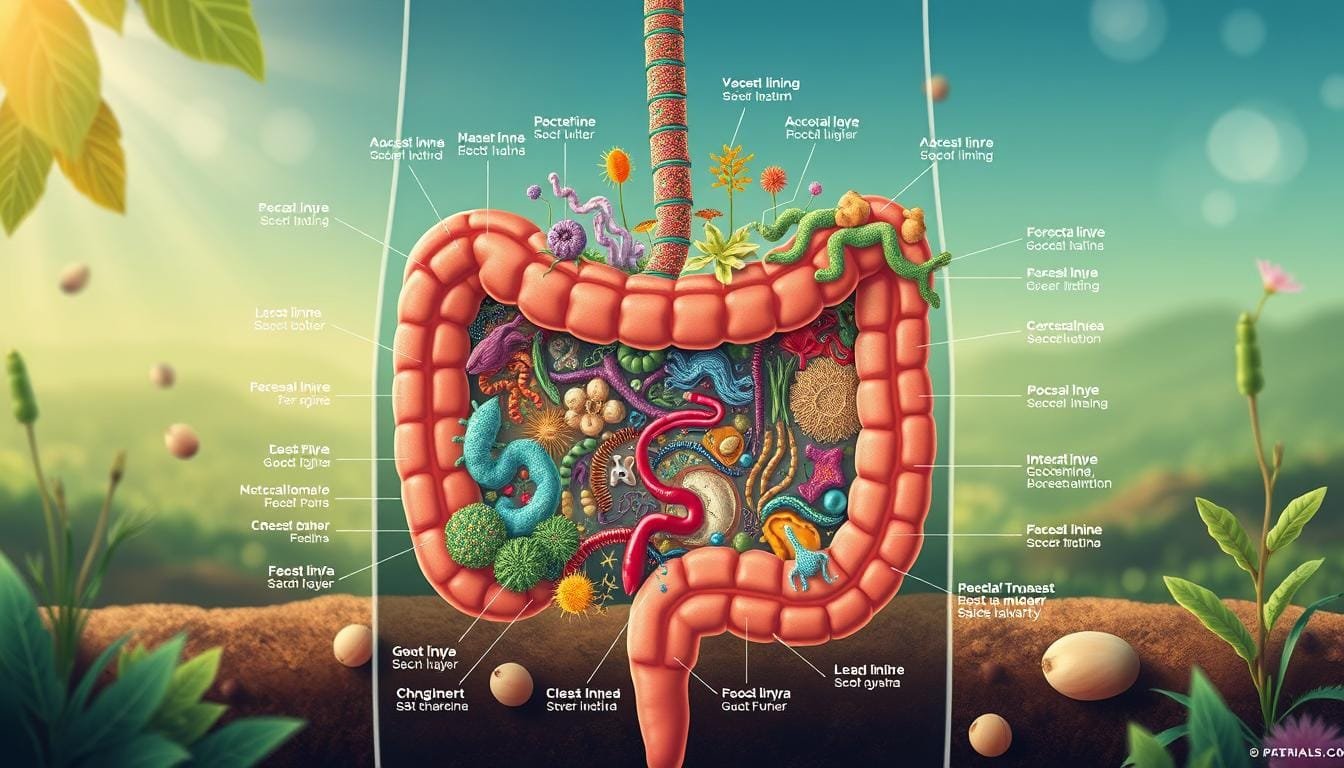Currently Empty: RM0.00
The human body hosts a thriving world of microscopic life essential to health. At the heart of this ecosystem lies a dynamic network of organisms working together to support digestion, immunity, and overall wellness. Visual tools like detailed diagrams help simplify these complex relationships, making cutting-edge science accessible to everyone.
Recent advances reveal how microbial communities in our digestive system influence everything from nutrient absorption to mood regulation. Researchers now map these interactions with precision, uncovering connections between lifestyle choices and long-term health outcomes. Wellness Concept leads this exploration, combining innovative data analysis with practical wellness strategies.
This article breaks down how modern visualization techniques transform raw scientific data into actionable insights. Readers will discover how factors like diet, stress, and environment shape their unique biological landscape. The journey through this hidden world highlights why understanding these systems matters for personalized health approaches.
Key Takeaways
- Visual diagrams simplify complex microbial ecosystems in the digestive tract
- Modern research connects microbial activity to immune and mental health
- Lifestyle factors continuously reshape microbial communities
- Advanced mapping tools enable personalized health strategies
- Science-based visuals bridge research and practical wellness solutions
Introduction to the Gut Microbiome Diagram
The digestive tract hosts an intricate network of organisms influencing various bodily functions. This living system outnumbers human cells tenfold, creating a dynamic partnership that shapes everything from nutrient processing to disease prevention.
Defining the Human Gut Microbiome
Our lower intestines contain over 300 unique microbial species, forming communities that:
- Break down complex carbohydrates
- Produce essential vitamins like B12 and K
- Train immune cells to recognize threats
These microscopic residents create protective barriers against harmful pathogens while communicating with the nervous system through specialized pathways.
Purpose of the Diagram in Trend Analysis
Modern visualization tools transform raw data into color-coded maps showing bacterial hotspots and activity patterns. Researchers use these diagrams to:
- Compare microbial diversity across populations
- Track changes after dietary adjustments
- Predict responses to medical treatments
For example, studies using these models helped identify how specific probiotic strains influence digestive comfort. Such visual tools make complex relationships understandable, empowering both doctors and patients to make informed health decisions.
Understanding the Human Gut Microbiome
Our digestive system contains more microbial life forms than stars in the Milky Way. These microscopic residents form intricate partnerships that directly impact how we process food, fight infections, and even think. Let’s explore the main characters in this biological drama.
Key Microbial Players: Bacteria, Fungi, and Viruses
Bacterial communities rule this hidden world, outnumbering human cells in surprising ratios. Most thrive without oxygen, breaking down fiber into nutrients while producing vitamins like B12. Their sheer numbers – about 38 trillion – create protective barriers against harmful invaders.
Fungal species like Candida live in careful balance with their bacterial neighbors. Though less abundant, they help digest complex sugars. The immune system keeps their populations in check, preventing overgrowth that could lead to health complications.
Viruses called bacteriophages act as bacterial regulators. These tiny agents infect specific microbes, controlling population sizes while transferring genetic material between species. This constant interaction helps maintain ecosystem stability.
These microorganisms don’t work in isolation. Their combined activities influence everything from metabolism to mental clarity. When antibiotic use or dietary changes disrupt their balance, the effects ripple through the entire system. Modern science now maps these relationships to develop targeted health solutions.
Detailed Components of the Gut Microbiome Diagram
The digestive landscape showcases dramatic shifts in microbial populations from entry to exit points. Advanced visualization tools map these variations with striking clarity, revealing how anatomy shapes biological activity.
Anatomical Regions and Microbial Distribution
From the stomach’s acidic chambers to the colon’s nutrient-rich environment, microbial communities adapt to survive. The stomach hosts hardy acid-resistant species like Lactobacillus, while the small intestine favors Enterobacteriaceae that thrive in alkaline conditions. Researchers note:
| Region | pH Level | Dominant Microbes | Key Functions |
|---|---|---|---|
| Stomach | 1.5-3.5 | Helicobacter, Lactobacillus | Acid neutralization |
| Small Intestine | 6.0-7.4 | Escherichia, Enterococcus | Nutrient absorption |
| Colon | 5.5-7.0 | Bacteroides, Faecalibacterium | Fiber fermentation |
Colon ecosystems contain 300-1,000 bacterial species, dominated by four phyla performing essential metabolic roles. Bacteroides break down complex carbs, while Clostridium species produce butyrate for colon cell health.
Insights from Metagenomic Studies
Modern sequencing techniques bypass traditional cultivation methods, analyzing genetic material directly from samples. One study found:
“Metagenomic data reveals 90% of gut microbes can’t be grown in labs—their functions decoded through DNA analysis.”
These methods identified genes responsible for vitamin synthesis and immune modulation. Researchers now track how targeted probiotic supplements influence specific microbial networks, creating personalized health strategies.
Insights from Recent Trend Analysis
Recent breakthroughs in biological research are rewriting our understanding of digestive ecosystems. Scientists now track microbial changes over weeks rather than single moments, revealing how breakfast choices or sleep patterns alter bacterial behavior. Multi-omics technologies – combining genetic, protein, and metabolic data – map these shifts with unprecedented detail.

One study followed 150 adults for 30 days, collecting daily samples. Results showed:
- 45% experienced noticeable microbial fluctuations within 72 hours
- Fiber intake caused faster changes than previously documented
- Stress levels correlated with reduced diversity in key bacterial groups
Researchers now link physical factors like intestinal transit speed to microbial composition. Faster movement favors oxygen-tolerant species, while slower digestion allows anaerobic bacteria to dominate. “Hourly changes matter more than we realized,” notes Dr. Aminah Rahman, whose team discovered pH levels shift dramatically after meals.
These findings challenge traditional analysis methods. Single lab tests might miss critical patterns, much like judging a movie from one frame. Emerging tools now combine stool tests with lifestyle tracking apps, creating dynamic maps of microbial ecosystems. This approach helps explain why identical diets affect people differently.
The push for personalized health solutions grows stronger as data reveals unique microbial fingerprints. Future studies aim to predict individual responses to foods or medications using real-time tracking – a game-changer for digestive wellness strategies.
Research Methods: 16S rRNA Gene Sequencing and Beyond
Modern research relies on precise methods to map microbial diversity within the digestive system. Two groundbreaking approaches dominate this field: targeted gene analysis and comprehensive genetic sequencing. These techniques help scientists decode complex biological networks with remarkable accuracy.
Marker Gene Analysis Explained
The 16S rRNA gene acts like a biological ID card for bacteria. Scientists amplify specific regions of this gene through sequencing, creating detailed profiles of microbial communities. This method works because all bacterial species carry unique variations in their 16S rRNA sequences.
Key advantages include:
- Cost-effective analysis of large sample batches
- Clear identification of dominant bacterial groups
- Standardized comparisons across studies
However, this approach struggles to distinguish closely related species. It also can’t reveal what metabolic processes these microbes perform daily.
Advancements in Shotgun Metagenomics
Shotgun methods take genetic analysis to new heights by examining all DNA in a sample. Instead of focusing on one gene, this technique sequences random fragments from entire genomes. Powerful computers then piece together these genetic puzzles.
Recent innovations allow researchers to:
- Detect rare microbial species often missed by older methods
- Map antibiotic resistance genes in real time
- Analyze how different organisms work together metabolically
A 2023 study demonstrated how this method identified 18 previously unknown bacterial interactions linked to digestive health. Such discoveries drive personalized treatment strategies forward, making science more actionable for everyday wellness.
Reviewing Microbial Composition and Diversity
Microbial communities in our bodies work like intricate teams, each member contributing unique skills. Scientists study these groups to understand how their balance affects health. 
The Role of Alpha Diversity
Alpha diversity acts like a microbial census, measuring how many species live in one area and how evenly they’re distributed. Tools like the Shannon Index score this balance – higher numbers mean richer, more stable communities. Adults typically show greater diversity than children, suggesting our inner ecosystems mature with time.
Here’s how microbial landscapes change with age:
| Age Group | Diversity Level | Key Features |
|---|---|---|
| 0-3 Years | Low | Rapid changes, unique personal patterns |
| Adults | High | Stable communities, shared core species |
Babies develop 70% of their lifelong microbial makeup by age three. Breastfeeding, early foods, and environment shape this foundation. “Diversity isn’t just about numbers,” notes a 2022 study. “It’s about creating resilient networks that adapt to life’s challenges.”
Researchers use these insights to spot trouble signs. Low alpha diversity often appears before digestive issues or weakened immunity. Modern analysis tools now track these changes weekly, helping people make timely diet or lifestyle adjustments.
Linking Gut Microbiome to Inflammatory and Irritable Bowel Disorders
Recent studies reveal surprising connections between microbial balance and chronic digestive issues. Imbalances in bacterial communities often appear months before symptoms of bowel disorders emerge. This discovery opens new doors for early intervention strategies.
Impact on Immune Response and Inflammation
Inflammatory bowel disorders show clear links to reduced diversity in intestinal bacteria. When key species disappear, the immune system may overreact to harmless substances. This triggers inflammation that damages intestinal walls over time.
Researchers found people with irritable bowel syndrome often lack specific microbes that produce calming compounds. Without these natural regulators, nerve signals between the brain and intestines become exaggerated. Simple meals can feel like digestive emergencies.
Modern analysis tools now track these changes in real time. Doctors use this data to recommend targeted probiotics or dietary adjustments. For example, increasing fiber intake often helps restore populations of butyrate-producing bacteria within weeks.
Emerging treatments focus on rebuilding microbial partnerships rather than just eliminating symptoms. As science uncovers more connections, personalized approaches become key to managing chronic digestive challenges effectively.
FAQ
Why is the human gut microbiota considered essential for health?
The community of microbes in the digestive tract aids digestion, supports immunity, and produces vital nutrients like short-chain fatty acids. Imbalances here are linked to conditions such as irritable bowel syndrome and metabolic disorders.
How does a gut microbiome diagram help in trend analysis?
These visuals map microbial distribution across anatomical regions, highlighting shifts tied to diet, disease, or treatments. Researchers use them to track patterns in microbial composition over time or between populations.
What role does 16S rRNA gene sequencing play in studying microbial communities?
This method identifies bacteria by analyzing a specific ribosomal RNA gene region. It’s cost-effective for profiling diversity but lacks the detailed functional insights provided by shotgun metagenomics.
How does alpha diversity relate to gut health?
Alpha diversity measures the variety of species within a sample. Higher diversity often correlates with better health, while reduced levels are observed in inflammatory bowel disease or antibiotic use.
What advancements have improved our understanding of microbial composition?
Techniques like shotgun metagenomics now allow full genetic analysis, revealing not just “who’s there” but also what metabolic roles they play. This helps connect specific microbes to host interactions or disease mechanisms.
Can gut microbes influence irritable bowel disorders?
Yes, studies show altered microbial composition can trigger inflammation, disrupt the gut barrier, or affect motility. Targeting these communities through diet or probiotics is a growing research focus.


